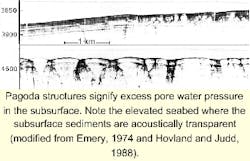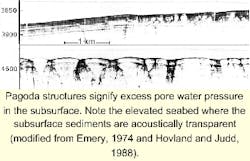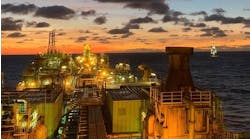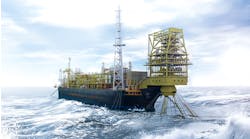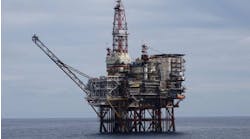Predicting over-pressure is one of the major challenges facing the oil industry, in particular as exploration moves into deeper water. Very high porosity and water content are typical for fine-grained sediments at shallow sediment depths in the marine environment.
Over about 20 years, Statoil has worked to improve its seismic interpretation practice by utilizing information gained from shallow sediment depth on high-resolution seismic data. Using typically 3.5-kHz high-resolution data, the work has become especially relevant for deep water applications, where the thickness of low sediment consolidation is generally greater than at shallow water depths.
Because gases in marine sediments are ubiquitous, especially in hydrocarbon producing areas, learning to ground truth and interpret the typical gas-associated signatures on high-resolution records has paid off, especially for hazard evaluation. The presence of gas-charged sediments often leads to over-pressuring of pore waters in adjacent, low-permeability sediment bodies. The "tidal pumping" model mentioned by Hovland and Judd today is used to explain why excess pore pressures often occur adjacent to shallow gas-charged sediments.
We will illustrate the appearance of excess-pressure zones in un-lithified sediments on both high-resolution data and conventional 2D seismic. We will also explain the governing formation mechanisms. In the near future, we intend to go one step further and use seismic modeling techniques to further test the model numerically by producing synthetic seismograms.
Tidal pumping
Our interpretation model goes back to the interpretation of various high-resolution seismic records in the mid-1980s. Hovland and Curzi found that an acoustically transparent zone on a high-resolution seismic record could best be explain ed by the presence of excess pore pressure.
Another indicator of excess pore pressure is a slightly increased elevation (a "lifting") of the local seabed surface (see figure). Today, we have a more complete explanation. The model is based on a theory for the continuous upward flux of gas molecules, which must be occurring in any hydrocarbon producing environment.
Furthermore, it is based on the hydraulic or tidal pumping idea, and the fact that a single-phase fluid (water) moves more readily through sediment pores than a multi-phase fluid. This effect causes segregation of free gas and gas dissolved in pore water. The "motor" in the system is the continuous cyclic loading by tidal forces and storm surges occurring in any marine environment.
In a study on the effects of gassy marine sediments for engineering, Sills and Wheeler concluded: "The presence of undissolved gas can change the soil response to external loading, associated with the compressibility of the soil. The bulk modulus is no longer infinite, and volume changes occur even during an undrained response to load.
"One of the ways of examining the significance of this effect is by consideration of surface movements under one-dimensional conditions. In this situation, no undrained movement would occur without the presence of gas. The magnitude of the deformation will be determined by the applied load, the soil stiffness, and the gas content. Substantial movements have been measured in the laboratory for very soft soils."
Even though these "substantial movements" mentioned here might only be in the millimeter scale, it is the actual occurrence of cyclic movements in the sediment pore water system that is of utmost importance. These results explain how the presence of gas bubbles will act as an effective "actuator" or "buried motor" in the sediments.
Each bubble reacts to high tide (including storm surges) with contraction and low tide with expansion.
A sediment volume containing free gas (seen on seismic as a bright-spot or enhanced reflector) where all bubbles react synchronously and contract and expand in harmony, will therefore act as a bellows on nearby water-saturated sediments, which are more or less incompressible. Besides sending regular pressure pulses into the surrounding water-saturated sediments, this "pumping" effect may also accentuate gas and pore water migration through the pore water system of the sediments.
Creating reservoirs
Holbrook has recently explained how hydrocarbons in a pore water solution and in a two-phase system can contribute towards producing segregated and isolated shallow pockets (or reservoirs) of free gas. He also explains simply why pore water flow is more common through the sediments, rather than a two-phase flow: "It takes much more work to force a two-phase fluid into a capillary size fracture or pore than for a single-phase fluid.
"The increased pressure required is about double that of a single phase fluid, depending mostly upon aperture size and non-wetting fluid contact angleellipse migrating hydrocarbons are trapped by capillary pressure while migrating water at the same pressure is not."
Whereas pore water with dissolved methane is free to migrate through the pores, evolving free gases are not. On ascent and de-pressurization of vertically migrating pore water, these free gases will form and accumulate in areas of the water-saturated sediment body wherever possible, and form small gas pockets depending on the local in situ porosity and permeability. The trapping mechanism for such shallow gas pockets will be capillary, rather than by changes in lithology.
Even so, once a shallow gas accumulation has formed, it will act as any other buried hydrocarbon reservoir: "When the pressure in the compartment, which is exposed to the valve, exceeds the fracture propagation pressure, the valve will open. Fracture permeability increases exponentially as pore pressure approaches caprock fracture propagation pressure," according to Walsh.
"With fluid release, fluid pressure within the compartment will fall until the fracture closes at fracture propagation pressure," says Holbrook. The "compartment" mentioned here is our observed free gas pocket. The "valve" is a fissure or any other vertical weakness in the sediments confining the gas pocket.
Examples
There are a large set of features associated with pore water pressured by gas-charge (see figure) including the following:
- Acoustically turbid zones caused by gas-charge (contains free gas bubbles)
- Acoustically transparent sediment zones, i.e. but with dissolved gas in a higher-than-hydrostatic pressure environment
- Small columnar acoustic voids or transparent zones, indicating high pore pressure transmitting into shallower sediments
- Acoustic voids in deformed sediments (shale, diapiric structures rooted in the shallow zone with the columnar voids)
- Finely layered undisturbed upper sediments
- Gas seepage associated with one of the shale diapirs
- Diapiric structures on the seabed
The observed gas seepage at one of the diapiric structures on the seabed in the figure can be explained by pressure release at the sediment/water boundary. When gas-saturated pore water of higher-than-hydrostatic pressure makes contact with the seawater column, pressure is released forming bubbles (the champagne bottle effect).
Pagoda structures
Pagoda structures are noted where subsurface acoustically transparent (or void) zones occur (see figure). Here, all coherent reflections tend to disappear. At first, when these features were discovered, they were thought to represent artifacts. On one occasion, the survey vessel propulsion was even turned off and the vessel drifted slowly across one of the features.
Because the acoustic feature was still there, and because it had grown in size proportionally to the traverse speed reduction, it had to be concluded that the feature was but another of nature's many mysteries. However, on closer examination it can be noted that the seabed is slightly elevated above the transparent zones.
This could be the result of excess pore pressure inside the zones. Any seepage of pore water or gas from such an area would probably occur where the pressure was highest (at the base or top of such structures).
Acoustically transparent zones are not only seen on shallow seismic records. In deepwater areas with shales, such as off the outer Niger delta, such zones can easily be detected and mapped on 2D and 3D seismic sections.
Transparent zones
Another figure shows acoustically transparent zones interpreted as over-pressured aquifers. There are also acoustically high reflective zones (bright spots) where it is expected that free gas bubbles occur in the sediments. Some of these zones have reverse polarity.
There are acoustically transparent zones where the pore pressure is expected to be slightly higher than hydrostatic, and where the gas is (suspected to be) fully dissolved in the pore water (see accompanying figure). Also, there are some vertical faults, some of which represent pressure barriers and migration pathways for gas-charged pore water. Finally, there is evidence of deformed shales caused by hydrofracturing and pressure transmission.
Questions
One of the remaining questions to be answered is why the high-pressured zones occur as acoustically transparent or blank (void) zones. One answer could be that the locally higher pressure increases the bulk water content of the sediment, and thereby increases the volume, thus producing a fluid-supported sediment system, rather than grain-supported sediment. It is suspected that the acoustic P-waves travel through these zones as if they consisted of pure water, without detecting impedance contrasts and therefore without providing any coherent reflectors.
There is other information recorded from deep ocean sediments that support such an explanation model. When Schuttenhelm et al. (1985) sampled silty clay from the Nares Abyssal Plain in the Atlantic Ocean, where pagoda-like structures occur, they found the porosity of the sediments to vary 75-80%, with water contents as high as 140%. The water content in adjacent silt layers was only 30%. The water content of sediments is calculated as a percentage of weight wet sediment, compared to the weight of dry sediment.
We believe this interpretation model provides an improved way of rationally predicting excess formation pressures in unlithified sediments. It is preferable to drilling more or less blindly or "guestimating" the pressure distribution on the basis of other indirect methods.
Acknowledgements
The authors wish to thank Statoil, TGS-Calibre Geophysical Company, and Mabon Limited (TGSI/Mabon) for the release of the one of the data examples shown.
A list of references is available upon request.
